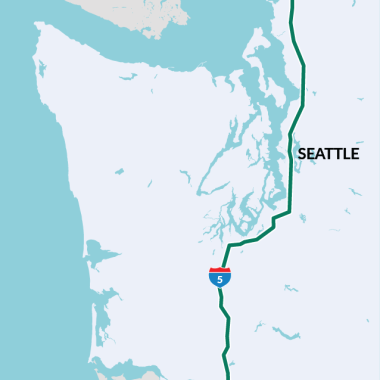Planning study news
In December 2024, WSDOT submitted two reports to the Legislature. The I-5 Master Plan Future Phases and Funding Plan outlines the next steps and funding needed to develop the I-5 Master Plan. The I-5 Ramp Reconfiguration Study informs future City of Seattle lid planning and work to be conducted during WSDOT’s I-5 Master Plan. These reports can be found in the “Outcomes” section below. The Program is currently in the initial stages of developing the I-5 Master Plan.
Purpose
The I-5 Master Plan is part of WSDOT’s Cascadia High-Speed Rail and I-5 Program to address the future transportation needs of western Washington communities. The integrated Cascadia High-Speed Rail and I-5 Program allows us to look holistically at highway, rail, and other travel options.
In Spring 2022, the Legislature initiated the Move Ahead Washington funding package for initial studies on the future of the I-5 system, providing the framework for a border-to-border I-5 Master Plan. WSDOT then began initial planning and data collection and launched the I-5 Master Plan process.
Once complete, the I-5 Master Plan will identify, prioritize and direct investments to address both near- and long-term needs along the I-5 corridor in Washington between Oregon and British Columbia. The Master Plan will also identify opportunities for innovation in the I-5 system’s future.
History
The I-5 Study evolved from the work conducted by the I-5 System Partnership. The partnership was a diverse group of stakeholders who recommended the development of an I-5 System Master Plan to identify specific improvements that should be made to each part of the I-5 system.
The partnership worked collaboratively throughout 2018 and 2019 to review the pressing challenges of the I-5 system, and to establish a set of goals and strategies to support future generations and help meet the challenges of continued growth in a way that protects our economy, environment and communities.
The partnership’s goals and strategies are consistent with adopted regional visions of the Puget Sound Regional Council (PSRC) and the Thurston Regional Planning Council (TRPC).
Washington is expecting tremendous growth. I-5 requires significant transportation investments to function currently and the challenges on the interstate will only multiply as we grow.
To address all of this, the Washington State Legislature began proactively planning for our future growth. In Spring 2022, the Legislature initiated the Move Ahead Washington funding package to take steps to develop an I-5 master plan that sets priorities from border to border for a robust north/south corridor and reflects WSDOT’s strategic plan, which includes resiliency, equity, and workforce development goals.
Listening Sessions
Between August 2022 and April 2023, the I-5 Study team conducted listening sessions with a wide range of transportation interests. The team heard from 137 different jurisdictions, tribes, agencies and organizations, including those representing underserved communities.
During the sessions, participants shared information about their planning efforts and active projects around the I-5 corridor, current challenges and future opportunities for I-5 transportation system improvements.
Listening session participants throughout the I-5 corridor shared feedback around the following themes:
- Equity, inclusion, diversity, and accessibility.
- Preservation investments.
- Connected communities and accessible I-5 crossings.
- Congestion relief.
- Freight mobility efficiency.
- Improved multimodal operations and transit.
- Seismic and climate-related resiliency.
A detailed report of our listening session efforts can be found in the Listening Sessions Feedback Summary (PDF 4.6MB).
Additional resources
- I-5 Strategic Corridor Opportunities Report (PDF 546KB) December 2023
- I-5 Master Plan Interim Report (PDF 2.8MB) June 2023
- I-5 Near-Term and Longer-Term HOV Lane Recommendations (PDF 2.4MB) June 2023
- Seismic Report and Funding Request (PDF 1.4MB) December 2022
- I-5 System Partnership Call To Action (PDF 12.8MB)
- I-5 System Partnership Strategic Framework (PDF 158KB)
- I-5 System Partnership Meeting Dates and Topics (PDF 316KB)
- Washington Transportation Plan (WSDOT and WSTC)
- State of Transportation 2019 (WSDOT)
- Regional Transportation Plan (PSRC)
- Sustainable Thurston (TRPC)
- 2040 Regional Transportation Plan (TRPC)
- Round One of the I-5 Near-Term Action Agenda (PDF 1MB)
- Round Two of the I-5 Near-Term Action Agenda (PDF 1MB)

